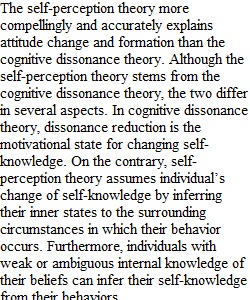


Q Reflection Paper 5 Instructions The debate between Cognitive Dissonance Theory and Self-Perception Theory (SPT)'s different explanations of attitude change/formation has continued since Bem's original formulation of SPT. Both attempt to explain similar findings in vastly different ways. Which theory do you find to be a more compelling and accurate explanation of attitude change and formation? Your explanation could favor either approach, neither, or even both- make sure it's clear which side(s) you're arguing. What is it about the theory(ies) that do not provide compelling explanations? Make sure in this paper to cite either the papers appropriately (if you're arguing for Festinger & Carlsmith, 1959, make sure to cite the paper properly in your references, same with the Bem paper). In addition to the paper cited, you will need to provide an additional reference that supports your argument. That additional reference should be from a peer-reviewed journal, much like the literature cited in your research proposal. Paper Content: The reflection paper should be 2 pages, double-spaced, using size 12 Times New Roman font and must be in APA format. Your reflection should be typed and well-edited. Your paper will be evaluated on critical thinking, application of course material, and clarity of your analysis and discussion. Poor editing and writing will affect your score. Plagiarism will result in an automatic 0 for the assignment and referral to Wingate Academic Integrity. Grading Rubric: Papers will be given a score out of 10 points. The grading rubric and breakdown is provided below Paper was formatted correctly (APA format): 1 point Clearly explain your point in support of cognitive dissonance, SPT, neither, or both: 3 points Clearly explain your opposition to the theory(ies) that you do not agree with: 3 points Providing an additional reference to back up your point: 2 points APA formatted references: 1 point
View Related Questions